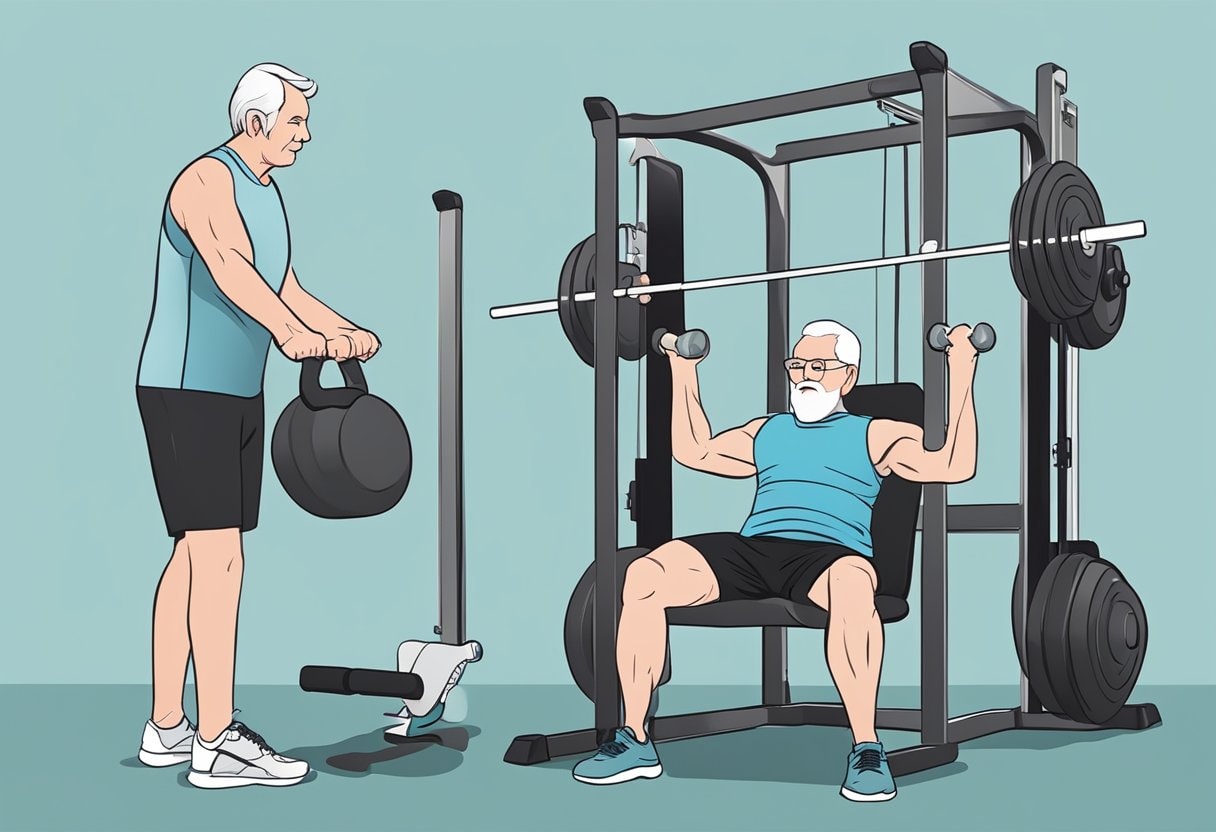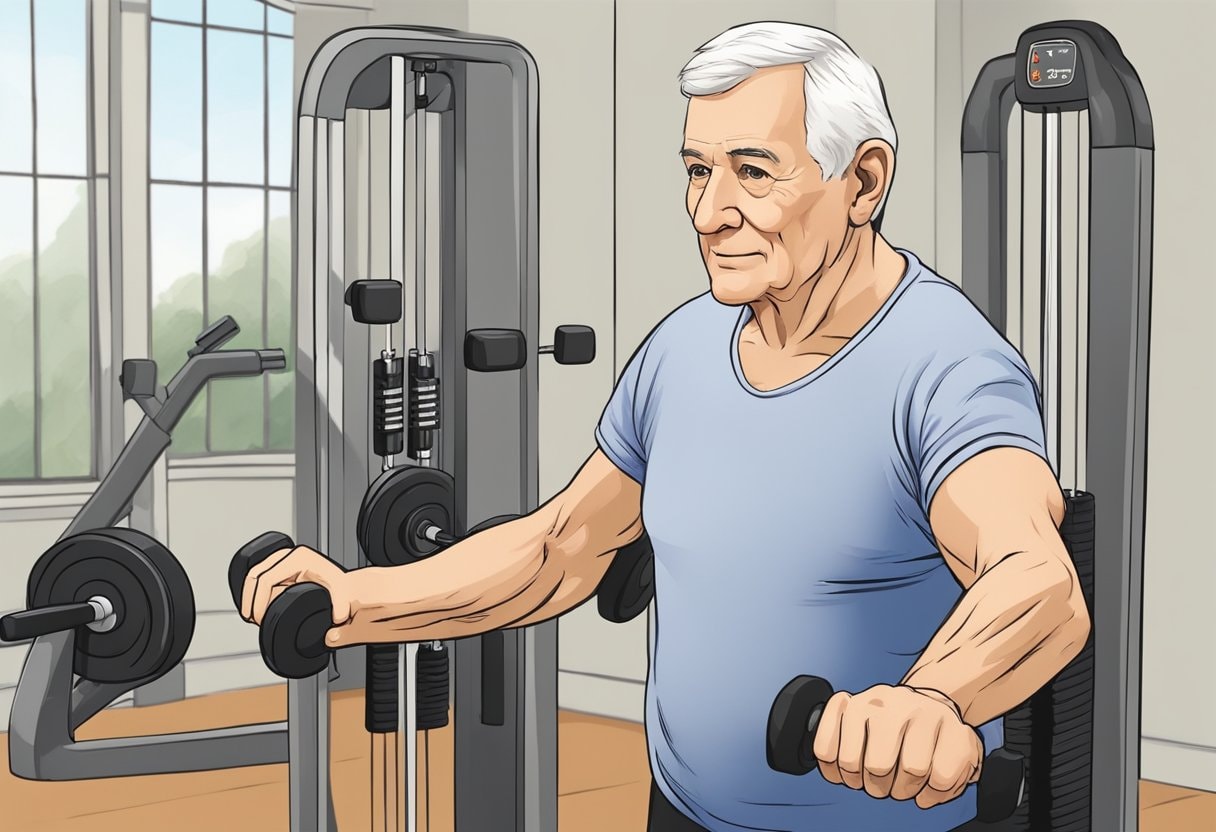Starting a strength training routine can be a game-changer for anyone over 55; there is always time to begin. This article delve into essential strength training tips for beginners over 55, showing how to embrace this fitness approach to enhance muscle tone, improve balance, and boost overall vitality. Discover how a few simple adjustments can significantly impact your fitness journey and well-being.
Empower Your Fitness: Essential Strength Training Tips for Beginners Over 55

Embarking on a strength training journey over 55 can be a transformative and rewarding endeavor, improving your muscle mass, bone density, and overall mobility. It is important to first understand the fundamentals of strength training, which involve exercises that challenge your muscles by using resistance, such as from weights or your body weight. These basics will set a solid foundation for a sustainable and effective exercise regimen. When you commence a strength training routine, it’s essential to establish clear and achievable goals to help guide your progress.
Tailoring a workout plan to suit your needs will ensure that you remain on track while keeping safety and proper technique at the forefront. As your body changes, your workout plan will also require adjustments to continue to be challenging and beneficial. Adhering to a balanced diet and keeping hydrated are key components for gaining strength and recovering from workouts. When faced with obstacles such as setbacks or injuries, the right approach and mindset will help you overcome these challenges.
Key Takeaways
- Strength training enhances muscle and bone strength, which is critical as you age.
- A personalized workout plan and realistic goal-setting are vital for success.
- Proper nutrition, hydration, and adapting workouts over time contribute to continued progress.
Understanding the Basics of Strength Training
Strength or resistance training involves exercises designed to improve your muscular fitness by exercising a muscle or a muscle group against external resistance. For those over 55, incorporating strength training into your routine can be especially beneficial, as it helps maintain bone density and muscle mass. If you’re starting, our Strength Training Tips for Beginners Over 55 will guide you through the essential components of a basic strength training program. These tips will ensure you build strength safely and effectively, enhancing your fitness and well-being.
- Frequency: Aim for two to three times per week, allowing at least one day of rest between sessions to let your muscles recover.
- Intensity: Choose a weight or resistance level that makes your muscles feel tired after 10 to 15 repetitions.
- Type of exercise: Focus on working all major muscle groups—arms, legs, shoulders, chest, back, and core.
- Progression: Gradually increase the weight, resistance, or intensity as your strength improves to continue making gains.
Remember to start slowly, paying attention to your form to avoid injuries. Opt for exercises that are comfortable and manageable at your current fitness level. Consider tools like free weights or machines, which can perform various exercises targeting different muscle groups.
Alternatively, explore bodyweight exercises or tools like resistance bands for a versatile and convenient option you can use anywhere. By adhering to these principles, you are laying a strong foundation for your strength training regimen. Remember, consistency is key to long-term success.
Setting Realistic Goals

When embarking on a strength training journey, especially with our strength training tips for beginners over 55, it’s crucial to set challenging and attainable goals. This foundation will help you stay focused and motivated throughout your fitness journey.
Assessing Current Fitness Level
Before setting out your goals, you need to understand your starting point. Take stock of your fitness level by considering flexibility, endurance, and strength. This could involve noting how long you can walk without getting out of breath or how many squats you can do without stopping. Use this baseline to tailor your goals to your capability.
Establishing Achievable Milestones
Set incremental milestones to track progress once you’ve gauged your fitness level. These should be Specific, Measurable, Achievable, Relevant, and Time-bound (SMART). For instance:
- In one month, aim to increase your walking time by 5 minutes.
- Work towards completing one additional push-up each week.
Remember, these milestones are not set in stone; adjust them to align with your capabilities and health. For guidance on crafting these goals, reading about designing realistic fitness goals could be beneficial. Striking the right balance between challenging yourself and acknowledging your body’s limits will be key to your progress and overall well-being.
Designing Your Workout Plan
Creating an effective workout plan involves understanding your physical capabilities and aligning your fitness goals with exercises appropriate for your age and experience. For those seeking Strength Training Tips for Beginners Over 55, making informed decisions about the exercises you choose, the frequency of your workouts, and the importance of rest can lead to a sustainable and beneficial strength training regime.
Choosing the Right Exercises
When starting your strength training journey, select exercises that work for multiple muscle groups simultaneously, such as squats and push-ups, to maximize your time and efforts. Combine these with exercises that target specific muscle groups, like bicep curls and tricep dips, for a balanced workout. It’s essential to focus on form before adding weight to protect your joints and maximize each exercise’s benefit. A balanced approach might look like this:
- Full-body Workouts: Squats, lunges, push-ups.
- Upper Body: Overhead press, bicep curls, tricep dips.
- Lower Body: Leg curls, calf raises.
- Core Stability: Planks, bird dogs.
Determining the Frequency of Workouts
Your body requires time to adapt to new stressors, so start with two to three weekly strength training sessions. Spread these sessions out to give your muscles time to recover and grow. Adjust the intensity and volume of workouts as you progress, allowing for more frequent training if desired while avoiding overtraining.
Incorporating Rest and Recovery
Rest and recovery are paramount in your training plan. Your muscles need time to repair and strengthen between workouts. Aim to integrate at least one full rest day between strength training sessions. Additionally, get quality sleep and consider gentle activities like yoga or light walking on rest days to promote muscle recovery and flexibility.
Executing Exercises Safely
When engaging in strength training over 55, safety is paramount. Ensure you learn proper technique, select appropriate equipment, and heed your body’s signals to prevent injuries.
Learning Proper Form
The foundation of safe strength training is proper form. You should start with light weights or just body weight to practice the movements. Consult a trained professional or watch reputable instructional videos to understand each exercise’s mechanics.
Using the Right Equipment
Selecting the right equipment is essential for your safety. Begin with weights that allow you to comfortably perform 10-12 repetitions. Equipment should be adjustable to adapt to your strength levels without compromising form.
Listening to Your Body
Your body provides valuable feedback, so it’s crucial to listen to it. If you feel pain or discomfort beyond normal muscle fatigue, it might be a sign to stop or modify the exercise. Rest and recovery are just as important as the workout itself.
Did you Know?
Seniors over 55 should aim for weightlifting sessions two or three times per week, allowing for at least one day of rest between workouts. This frequency is optimal for muscle growth and recovery.
Nutrition and Hydration for Strength Gain

As you embark on your strength training journey, incorporating key Strength Training Tips for Beginners Over 55 is crucial. Paying close attention to your nutrition and hydration is as critical as the workout. These elements are the building blocks for muscle repair and growth, ensuring that your strength training efforts yield the best results.
Balanced Diet Essentials
To support strength training, your balanced diet should consist of various macronutrients. Proteins are vital for muscle repair and should be included in every meal. Aim for lean sources like grilled chicken and fish or plant-based options like lentils.
Carbohydrates provide the needed energy; opt for complex carbs like brown rice and whole grains. And do not forget about healthy fats, including those found in nuts and avocados, which are essential for joint health and energy storage.
- Proteins: 20-30 grams per meal.
- Carbohydrates: 45-65% of your daily caloric intake.
- Fats: 20-35% of your daily calories, emphasizing unsaturated fats.
Staying Hydrated During Workouts
Hydration is key to performance and recovery. The right amount of water intake can vary based on factors like your sweat rate and the humidity. However, a general guideline is to drink at least 17-20 ounces of water two hours before exercise and then around 7-10 ounces every 10-20 minutes during your workout. If your workouts last longer than an hour, consider a drink with electrolytes to replenish sodium and potassium lost through sweat.
- Before workout: 17-20 ounces of water.
- During workout: 7-10 ounces every 10-20 minutes.
Supplements and Older Adults
As you age, your body may have specific nutritional needs. Calcium and vitamin D are crucial for bone health, while omega-3 fatty acids can help combat inflammation. While a well-rounded diet is the foundation, supplements might be necessary to fill gaps.
For instance, whey protein can be an easy way to increase your protein intake post-workout. Always consult a healthcare provider before starting any supplement regime to ensure they are needed and appropriate for your health status.
- Calcium: important for bone health.
- Vitamin D: aids in calcium absorption.
- Omega-3 Fatty Acids: help with inflammation control and joint health.
- Protein Supplements: consider for a post-workout protein boost.
Staying Motivated
Starting a strength training routine can be challenging if you’re over 55, but it becomes a rewarding journey with the right approach. Incorporating Strength Training Tips for Beginners Over 55 can significantly enhance consistency and improve results. By staying motivated and applying these strategies, you can maintain enthusiasm and dedication to your fitness journey.
Tracking Progress
Begin by setting measurable goals and track your progress. This can be as simple as noting the weights you lift each session or as detailed as logging your muscle measurements. Regularly seeing improvement, no matter how small, provides tangible evidence of your hard work and can fuel your motivation to continue. Workout Log Example:
Date: 02/01/2024
Exercise: Chest Press
Weight: 20 lbs
Reps: 12
Sets: 3
Finding a Workout Buddy
Pair up with a workout buddy who shares similar fitness goals. Your partner can offer support, encouragement, and accountability, making it more likely for you to stick to your training schedule. Plus, workouts can be more enjoyable when you have company. Benefits:
- Shared motivation.
- Accountability.
- Enhanced enjoyment.
Joining a Community
Engage with a community of like-minded individuals committed to strength training. This could be a local gym group or an online forum where you can share experiences, seek advice, and celebrate achievements. Being part of a community can provide a sense of belonging and additional motivation.
- Connect with a local fitness class.
- Join online strength training groups.
- Participate in community fitness events.
Strength Training Tips for Beginners Over 55: Adapting the Program Over Time

As you progress in strength training, adopting your exercise program to continue seeing results and prevent stagnation is crucial. Doing so will ensure sustained strength gains and help maintain your motivation.
Adjusting the Intensity
To keep gaining strength, you may need to increase your weight. As a general guide, a 1-3 lbs progression per workout can be optimal for beginners over 55. For instance:
- Weeks 3-4: Add a small increment of weight, typically 1-3 lbs, as you get comfortable with the exercises.
- Weeks 5-6: Continue incrementally increasing the weight while closely monitoring your body’s response.
Remember always to prioritize proper form to prevent injury.
Introducing New Activities
Integrating variety into your training can help keep the program fresh and challenge different muscle groups. Here are some examples:
- Body Weight Exercises: Incorporate exercises such as squats, push-ups, and planks.
- Resistance Bands: Use them for exercises targeting upper and lower body muscles.
- Balance Training: Simple activities like standing on one leg can benefit.
Try to incorporate resistance exercises at least twice a week. Consistent, varied workouts are better for progress than infrequent, monotonous ones.
Recognizing Plateaus
Recognizing when you’ve hit a plateau is key to adapting your strength training regimen. Signs may include:
- Lack of progress: Despite continued effort, your strength doesn’t seem to increase.
- Stalled weight: You can no longer lift heavier weights or increase your reps.
When you notice a plateau, it may be a signal to change your routine. Experimenting with different set and rep patterns, such as performing 2-3 sets of 8-15 reps, can catalyze progress.
Dealing with Setbacks and Injuries

Engaging in strength training after 55 means you may occasionally face setbacks and injuries. To navigate these challenges successfully, it’s essential to incorporate tailored strength training tips for beginners over 55. Effective management and mindful practices are crucial for a sustainable fitness journey and long-term success.
Understanding Common Injuries
Incorporating strength training into your routine can sometimes lead to common injuries such as strained or sprained muscles. These often result from overuse or improper form. Tendonitis and bursitis are also typical, usually manifesting in joints like the shoulder or knee. Being aware of your body’s limits is essential.
Approaches to Recovery
- Immediate Response: For most minor injuries, the R.I.C.E. method—rest, ice, compression, and elevation—can aid in reducing swelling and pain.
- Gradual Reintroduction: Once you’re healing, gently reintroduce movement to the affected area. Avoid strenuous activities that may aggravate the injury. Incorporating exercises to improve flexibility and mobility can help restore function.
- Rest: Allow time for recovery.
- Ice: Apply to reduce inflammation.
- Compression: Use bandages to support the injured area.
- Elevation: Keep the injury above heart level to decrease swelling.
When to Seek Medical Advice
Persistent or severe pain should prompt a visit to a healthcare provider. Professional evaluation is necessary if you experience symptoms such as sharp pain, swelling that doesn’t decrease, or an inability to bear weight on the affected area. Rehabilitation guided by a physical therapist may be recommended for optimal recovery.
- For sharp, acute pain or significant swelling, consult a doctor immediately.
- If you cannot use the injured area or bear weight, seek medical attention.
- A professional should assess chronic pain that persists for weeks.
Embrace Strength Training: Your Path to Health and Vitality Over 55
In conclusion, starting strength training over 55 is a transformative step toward improved health and vitality. Implementing the essential strength training tips for beginners over 55 can effectively build muscle, enhance balance, and increase overall energy levels while ensuring a safe and gradual approach. Understanding the basics, setting realistic goals, and customizing your workout plan to fit your needs are crucial for laying a solid foundation for success.
Consistency and attention to your body’s signals will help you stay on track and continue making progress. Remember, adapting your routine as you advance and incorporating proper nutrition and hydration are key elements for sustained improvement. Embrace strength training as a rewarding part of your fitness journey, and you’ll likely enjoy a healthier, more active lifestyle.
Frequently Asked Questions
What Are the Best Strength Training Exercises for Beginners Over 55?
For beginners over 55, focusing on exercises that build strength without overstraining the body is essential. Exercises like forearm planks, modified push-ups, and basic squats are excellent for developing core stability and muscle strength.
What Does a Safe and Effective Weight Training Routine Look Like for Men Over 50?
A safe and effective routine typically involves lifting weights two to three times a week, focusing on major muscle groups with a mix of machines and free weights. Programs often include exercises like shoulder presses and stability ball chest flys to ensure a balance of muscle growth and joint safety.
How Can a Senior Woman Begin Weight Training and What Are Suitable Exercises?
Starting with lighter weights and higher repetitions is a good way for senior women to begin weight training. Suitable exercises include stability ball triceps kickbacks, leg presses, and machine rowing, focusing on proper form and gradual progression.
Join Us to Embrace Vitality and Stay Energized!
Join the Fit After 55 community to fuel your enthusiasm for staying active and healthy. Explore our website for tailored tips, expert advice, and reviews designed specifically for seniors. Connect with our supportive health and fitness network on Facebook.
Let’s embark on this fitness journey together and prove that age is just a number!

